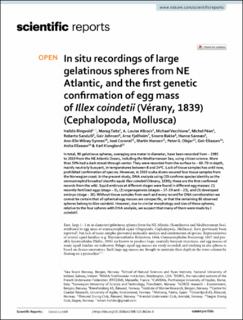In situ recordings of large gelatinous spheres from NE Atlantic, and the first genetic confirmation of egg mass of Illex coindetii (Vérany, 1839) (Cephalopoda, Mollusca)
Ringvold, Halldis; Taite, Morag; Allcock, A. Louise; Vecchione, Michael; Péan, Michel; Sandulli, Roberto; Johnsen, Geir; Fjellheim, Arne; Bakke, Snorre; Sannæs, Hanne; Synnes, Ann-Elin; Coronel, José; Hansen, Martin; Olejar, Peter; Eliassen, Geir; Eliassen, Anita; Klungland, Karl
Peer reviewed, Journal article
Published version
Permanent lenke
https://hdl.handle.net/11250/2786861Utgivelsesdato
2021Metadata
Vis full innførselSamlinger
- Articles [3012]
- Publikasjoner fra CRIStin [3066]
Sammendrag
In total, 90 gelatinous spheres, averaging one meter in diameter, have been recorded from ~ 1985 to 2019 from the NE Atlantic Ocean, including the Mediterranean Sea, using citizen science. More than 50% had a dark streak through center. They were recorded from the surface to ~ 60–70 m depth, mainly neutrally buoyant, in temperatures between 8 and 24°C. Lack of tissue samples has until now, prohibited confirmation of species. However, in 2019 scuba divers secured four tissue samples from the Norwegian coast. In the present study, DNA analysis using COI confirms species identity as the ommastrephid broadtail shortfin squid Illex coindetii (Vérany, 1839); these are the first confirmed records from the wild. Squid embryos at different stages were found in different egg masses: (1) recently fertilized eggs (stage ~ 3), (2) organogenesis (stages ~ 17–19 and ~ 23), and (3) developed embryo (stage ~ 30). Without tissue samples from each and every record for DNA corroboration we cannot be certain that all spherical egg masses are conspecific, or that the remaining 86 observed spheres belong to Illex coindetii. However, due to similar morphology and size of these spheres, relative to the four spheres with DNA analysis, we suspect that many of them were made by I. coindetii.
